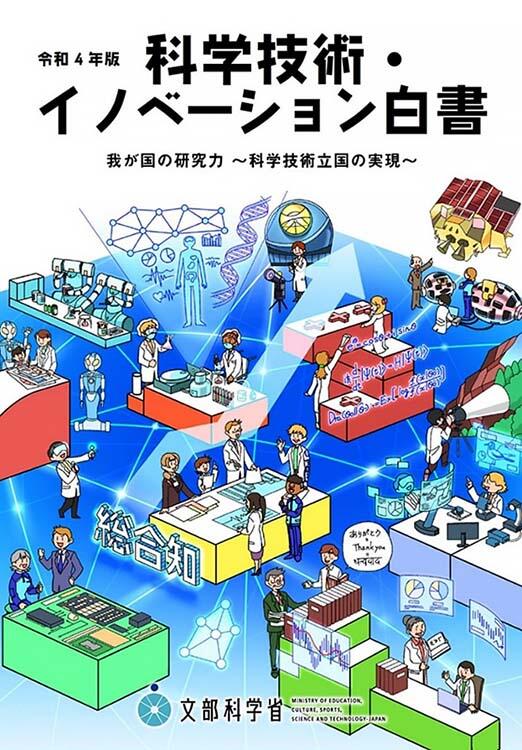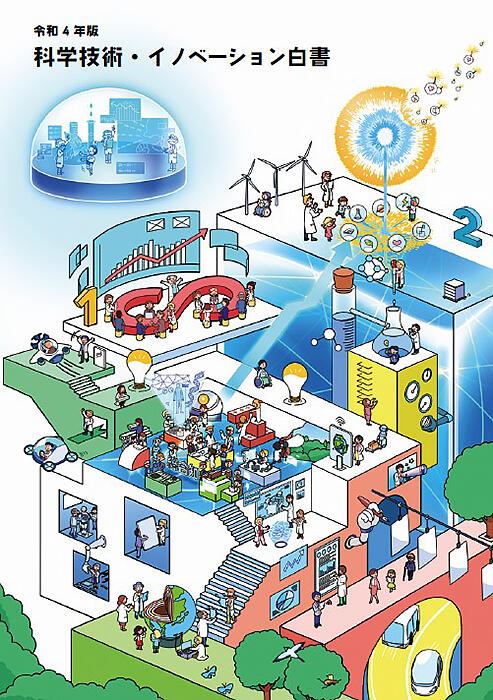
Provided by MEXT

Provided by MEXT
The annual report on promoting the creation of science, technology and innovation for the fiscal year, a.k.a. the White Paper on Science, Technology and Innovation 2022, has been approved at a Cabinet Meeting on June 14 th. This year's white paper promotes building Japan as a world leader in science and technology, a pillar of growth strategy of the Kishida Administration, and features Japan's Research Capabilities - Realizing a Nation Built on Science and Technology, as indicated in the Sixth Science, Technology, and Innovation Basic Plan, i.e., to restore the country to the world's highest level of research capabilities.
Chapter 1 of the white paper analyzes the current status and challenges of Japan's research capabilities by comparing them with those of other major countries in terms of the number of published papers and highly cited papers, the number of researchers at universities and other institutions, the ratio of research hours, and research and development expenditures. Though Japan is global leader in terms of the number of Nobel Prize winners in science related fields this Century and is ranked second place after the U.S., the number of papers published was fourth place, down from the second position 20 years ago, and the number of top 10% papers in tenth place, down from fourth. In terms of the number of papers published by organization types, those published by national universities has been on the decline from the mid-2000s but has started to turn up slightly since 2016. On the other hand, papers published from private universities has been on a constant increase, while those by national research and development agencies have been on a decline since the mid-2000s. Papers published by private companies have been on a decline since 1996, five years after the collapse of the bubble economy. In Japan, more than 70% of papers come from universities. The top four universities as well as local national universities, which have a significant share in the number of papers published, however, have seen a decline in terms of both the number of papers presented and top 10% most cited papers.
As to the reason for this fluctuation in the number of papers, the period from the late 80s to 90s showed an increase, due to an increased number of doctoral program students and faculty members, while for a decade from the mid-2000s, the number showed a decrease mainly due to decreased ratio of research time for faculty members and little growth in the number of teaching staff. In addition, during the 2010s there was a decline in number of papers because of the number of doctoral program students and direct research costs such as expenditure for raw materials being difficult to obtain.
In a questionnaire to researchers, the largest ratio of respondents replied that research time was the largest restriction for enhancing performance of their research activities, followed by research funds, research personnel and environment. In particular, actual research time is on a decrease year-by-year, and excessive load of educating students, university administrative tasks and lack of fundamental expenditure causing shortage in research budgets, which have all impacted the generation of papers.
In terms of human resources, the decrease in the number of young researchers is a major issue. A look at the trend of the number of full-time teaching staff in universities by age showed that those who are less than forty years-old are steadily decreasing, from 29.5% for fiscal year 2001 to 22.1% for fiscal year 2019. On the other hand, the ratio of those in their 50s and over and above 60 years-old are increasing, at 28.1% and 19.8% in fiscal year 2019 respectively.
The number of new doctoral students has been on a decrease after hitting its peak in fiscal year 2003. The number for fiscal year 2021 was about 15 thousand. Though the number of working adults enrolled in doctoral programs is on the increase, and the ratio of them to the entire doctoral program students has almost doubled compared to that in fiscal year 2003, and the ratio of master course students enrolled in doctoral programs has declined to 9.7% in fiscal year 2021.
Expenditure for research and development by universities (nominal amount translated by the OECD purchasing power parity) with the expenditure in 2000 set as 1 as a reference, shows a decrease to 0.9 for Japan, while it is growing nearly two to five-fold for other major countries. China in particular has shown large growth, with a 23.4-fold increase.
Looking back the policies for science, technology and innovation over the last 20 years, Chapter 2 picks up such topics as incorporation of national universities and national research and development agencies, dual support systems, subsidies for science and research and the JST Basic Research Program. Based on this, Chapter 3 explains about aids to young researchers and doctoral students and measures for improving research environments.
Chapter 4 introduces efforts towards social implementation of the "wisdom" generated through research and to make innovation happen. One of the challenges that Japan faces is that the results of research and development may not lead to solving real issues or social implementation. In order to reverse this trend, the chapter shows some measures the government is promoting, including the Cross-ministerial Strategic Innovation Promotion Program (SIP) through which inter-disciplinary collaboration between the Cabinet Office and ministries will be promoted in a form of industry-academia-government collaboration, which ranges from basic research through to practical use and commercialization. In order to respond to ever complicated social issues, the white paper shows also actions utilizing "comprehensive knowledge" through the integration of all kinds of "knowledge" including humanities, social and natural sciences, and explains how research and development has been undertaken to combat COVID-19 and the associated results.
About the cover images:
The cover images were drafted and designed by Manga Designers Lab. Co., Ltd. The cover design expresses the idea of "comprehensive knowledge," through the comprehensive utilization of diverse knowledge, including "knowledge" in the natural sciences and in the humanities and social sciences. It represents the creation of knowledge that springs from the gathering and connection of researchers in various fields. On the back cover, dandelion seeds dance in the air, expressing how this creates new value, one after another, and stretches toward the future.
This article has been translated by JST with permission from The Science News Ltd.(https://sci-news.co.jp/). Unauthorized reproduction of the article and photographs is prohibited.




